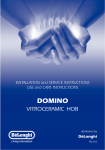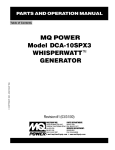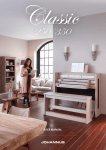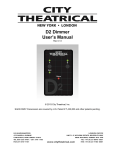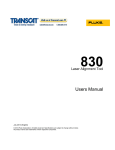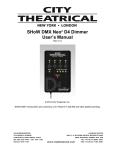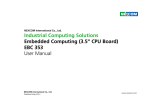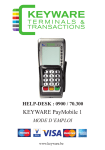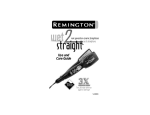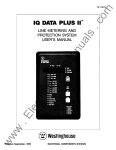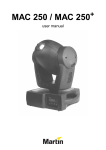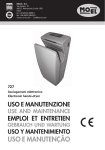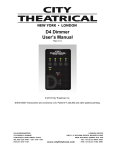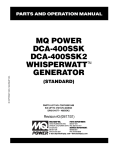Download Owner`s Operation Manual
Transcript
AQUASEAL ? AS60/80UV Pro Liquid Laminator Owner’s Operation Manual AS60/80UV Pro Liquid Laminator TABLE OF CONTENTS TABLE OF CONTENTS ....................................................................................................................... 2 INTRODUCTION.................................................................................................................................. 3 IMPORTANT SAFEGUARDS ............................................................................................................... 4 IMPORTANT SAFEGUARDS CONTINUED...................................................................................... 5 SAFETY FEATURES............................................................................................................................. 6 ELECTRICAL CABINET FEATURES.................................................................................................. 7 CONTROL PANELS.............................................................................................................................. 8 CONTROL PANELS (Continued).......................................................................................................... 9 CONTROL PANELS (Continued).......................................................................................................... 10 OVERVIEW OF OPERATING FEATURES........................................................................................ 11 LACQUER SUPPLY OPERATION....................................................................................................... 12 SET-UP AND OPERATION ................................................................................................................. 13 SHUT-DOWN OPERATION ................................................................................................................ 14 CLEANING THE COATING MACHINE............................................................................................. 15 MAINTAINING THE COATING MACHINE ...................................................................................... 16 UV LAMP OPERATION / MAINTENANCE ...................................................................................... 17 ROLLER SPEEDS AND COATING RESULTS ................................................................................... 18 ROLLER SPEEDS AND COATING RESULTS (continued)................................................................ 19 SPARE PARTS LIST............................................................................................................................... 20 TROUBLESHOOTING GUIDE............................................................................................................ 27 TECHNICAL SPECIFICATIONS (COATING SECTION ONLY)...................................................... 28 LIMITED WARRANTY.......................................................................................................................... 29 2 INTRODUCTION Thank you for purchasing a Seal AS60/80 UV Liquid Laminator. We have designed the Seal AS60/80 UV Liquid laminator to give you years of reliable service. As you become familiar with your liquid laminator, you will appreciate the high quality of its production and the excellence in its engineering design. By following the guidelines for proper care and use of the SEAL AS60/80UV, you can depend on many years of trouble-free profitability from your investment. Please read and fully understand the entire manual before proceeding to use your laminator. CAUTION! Please pay attention to all shaded passages. This information is vital to preventing user injury and/or damage to the unit. Failure to follow this information could void the user’s warranties and transfer all safety obligations to the user. STATEMENT OF INTENDED USE The SEAL AS60/80UV laminator is intended for use with medium and large format graphic output. Graphics can vary in widths from 100mm – 2032mm (4” – 80”). Mounted graphics can be up to 76mm (3 in.) thick. The SEAL AS60/80UV liquid laminator is intended for use with Seal AS lacquer only. Use of other manufacturer’s lacquers may damage the machine and will void any warranty. WARNING! This laminator is designed for liquid laminating. Any use other than the intended may cause damage to the laminator or physical harm to the user. WARNING! Any unauthorized changes or modifications to this unit without our prior written approval will void the user’s warranty and will transfer health and safety obligations to the user. LIABILITY STATEMENT The details given in this manual are based on the most recent information available to us. They may be subject to change in the future. We retain the right to make changes to the construction or the design of our products without accepting any responsibility for modifying earlier versions previously delivered. 3 IMPORTANT SAFEGUARDS SAFETY INSTRUCTIONS IMPORTANT! When using any equipment, always follow the manufacturer’s instructions for safe operation. ?? Make sure machine is connected to the proper power source. manufacturers recommendations when handling chemicals. To obtain MSDS Sheets for SEAL AS60/80UV Products, please call Seal at 31 572 346 000. ?? Comply with all safety warning signs, labels, and instructions. ?? Familiarize yourself with the layout of the Control Panel, and with the operation of the lacquer delivery system. SAFETY WARNINGS ?? Operators should be trained on the proper use of the machine and all safety procedures. R OTATING PARTS: R ISK OF INJURY ?? Provide ventilation, eye protection, clean towels and rubber gloves for use during cleanup. ?? It is advisable to wear eye protection when filling/emptying lacquer tank. Always provide an approved emergency eyewash station adjacent to the machine. ?? In case of skin contact with uncured lacquer, use soap and water to clean (do not use solvents to remove lacquer from the skin— solvents help lacquer to penetrate the skin). Repeated skin contact will result in a skin rash-uncured UV liquid is a skin irritant. Cured UV liquid does not irritate the skin. (1 box of latex gloves has been shipped with the machine.) ?? Review MSDS prior to working with UV material. WARNING! Ensure a clean well-ventilated work area. Avoid direct skin contact with uncured UV lacquer. Wear rubber gloves and UV blocking safety glasses. Failure to avoid contact with hot surfaces may cause burns. Do not look directly at the UV light source. CAUTION! When handling any chemical products, read the manufacturers’ container labels and the Material Safety Data Sheets (MSDS) for important health, safety, and environmental information. Always observe 4 CAUTION! Failure to use caution near rotating rollers could result in physical injury. Be careful that items such as loose clothing, long hair and jewelry do not become entangled in rotating parts. Beware of pinch points. Never operate machine with protective covers removed. Keep hands outside of machine when feeding materials into the machine. Never reach into machine when rollers are moving. E LECTRICAL P ARTS – D ANGER OF BEING INJURED BY ELECTRICITY WARNING! Do not open electrcal cabinet doors because of the risk of being injured by voltage. Only authorized maintenance and service technicians or safety personnel should have access to the electrical cabinet for mechanical /electrical upkeep or repair. IMPORTANT! Do not place heavy objects on the power supply cord. IMPORTANT SAFEGUARDS CONTINUED PREVENTATIVE MEASURES: Do not feed objects such as staples, paper clips and rough or abrasive materials through the laminating rollers. Keep all objects, such as tools, rulers, pens, markers or knives away from the roller opening. Refrain from leaving such items on the tables to prevent them from accidentally being fed into the rollers. IMPORTANT! NEVER cut or slice directly on the EPDM covered roller as any cuts, dents or gouges will destroy it and adversely affect the output. ALWAYS use cutters with enclosed blades to prevent cutting the roller and to avoid extensive replacement costs. exposure to UV light will result in a condition colloquially known as “welders flash”--the eyes will itch and burn or feel sandy for a period of time. This condition should be avoided. Permanent eye damage can result. (2 sets of tinted eyeglasses have been shipped with the machine.) SERVICING AND REPLACEMENT PARTS Service and maintenance must be performed fully in accordance with the instructions. Servicing by any unauthorized technician voids the warranty. The service technician must use replacement parts specified by Seal. UV Light Safety: Service Technicians must perform safety checks after completing any service or repairs to the laminator. Never look directly at the UV curing lamps. If working for extended periods at the machine wear UV blocking glasses (clear or tinted). Over WARNING! If your laminator does not operate correctly, contact Technical Service immediately. 5 SAFETY FEATURES The Seal AS 60/80 UV Liquid Laminator is designed with safety and protective devices with the user’s safety of utmost consideration. However, following safe operating guidelines is still the responsibility of the operator. H AND-OPERATED E MERGENCY STOP B UTTONS Six Emergency Stop buttons are located on the front and sides of the roller coating machine for easy access. These E-Stops are interlocked with the UV drying unit’s emergency stop system. If either switch is pressed, they immediately cease the operation of both machines. Use these only in the case of an emergency or you may damage an image during a process. NOTE! Whenever there is an emergency shut down you must wait 15 minutes before restarting the UV section to allow the UV lamp to cool down. NOTE: Once pressed, these buttons lock and must be turned clockwise to reset. To restart machine follow this procedure: a) Reset Emergency Stop Mushroom Switch by turning the mushroom until it pops up. b) On the Coater press the “SR Set” push button. Turn on the pump, motors, and scraper. c) On the Dryer, start the blower and the transport. d) After fifteen minutes the UV lamps can be turned on. 6 L OCKING C ABINETS The cabinets that house the inner workings of the laminator include locks that maintenance or safety personnel can open only with the supplied keys. WARNING! Use of the inside of the cabinets for storage may cause possible personal injury and/or damage to the inner workings and will void the warranty. MAIN SWITCH WITH DOOR INTERLOCK Located on the cabinet, it automatically shuts the laminator power off when the door interlock switch is turned to the OFF position. WARNING! For any servicing, ALWAYS turn the door interlock switch to the OFF position before opening the side cabinets. ELECTRICAL CABINET FEATURES Electrical Cabinet 1. Emergency Stop Buttons (2) ?? Located on the top of both side cabinets they immediately cease the operation of both machines. 2. Control panel system ?? Turns On/Off the liquid laminator and provides independent control of speed, roller direction , roller height, pump and read-out of UV lamp value. The speed control is independent of the UV dryer unit’s speed. 3. Override Key Switch ?? Used when cleaning up the UV Coating unit. When the lacquer valve is in the cleaning position, the pump cannot be turned on from the control panel. To activate the lacquer pump, press the ON/OFF pushbutton and turn on the cleaning override switch. 4. Main Switch with Door Interlock ?? Turning the Main switch to the Off position shuts down the operation of the machine and disengages the door interlock. 5. Power and Interface Plugs ?? Power supply Plug and UV Drying Unit Interface Plug. 7 CONTROL PANELS Coating Machine Electrical Controls: 8 CONTROL PANELS (Continued) S PEED CONTROL ?? The speed control sets the speed of the roller motor. ?? NOTE: The speed control for the roller coating machine is independent of the speed of the UV dryer machine. ?? ON/OFF P USHBUTTON ?? The On/Off Pushbutton controls the safety relay that supplies power to the machine. ?? R OLLER MOTOR CONTROL—IDLE, RUN, R EVERSE MODES ?? There are three operating modes for the roller motor as follows: ?? IDLE mode: the roller motor turns forward at a slow speed. ?? RUN mode: the roller motor turns forward at a speed determined by the motor speed control knob setting. ?? REVERSE mode: the motor turns backwards at a fixed, slow speed. ?? Press RUN/IDLE: the machine comes up in IDLE mode. ?? Press RUN/IDLE again: the machine comes up in RUN mode. ?? Press RUN/IDLE again : the machine comes up in IDLE mode. ?? Press REVERSE : the machine stops and then comes up in reverse mode—the IDLE indicator light will blink to indicate reverse. ?? Press REVERSE again : the machine comes up in IDLE mode. L ACQUER SUPPLY—PUMP ?? Press PUMP pushbutton : if the lacquer valve is in the return position the pump will start and the PUMP LED will come on. ?? Press PUMP again: the lacquer pump will turn off. ?? Press PUMP: if the lacquer valve is in the clean up position the PUMP LED will blink several times and then turn off; the pump will not turn on. MIDDLE C OATING R OLLER MOVEMENT—U P , DOWN ?? When the machine is turned on, one of the coating roller position lights will illuminate. ?? Press the UP or DOWN button to move to the next position. S CRAPER ADJUSTMENT . ?? The scraper cleans the bottom roller. When running un-mounted materials scraper adjustment is critical. There should be no lacquer streaks on the backs of coated materials. The scraper pressure is controlled by air pressure. The coating roller should be in the zero (down) position and the lacquer pump should be on. Scraper adjustment is controlled by an air valve labeled “Scraper Pressure”. Generally the scraper is run at 50-100 psi. When cleaning the machine with alcohol, scraper pressure should be reduced to 10-15 psi. Never engage the scraper with the bottom roller dry, ie always coat both rollers with lacquer before engaging the scraper. 9 ?? CONTROL PANELS (Continued) UV Dryer Electrical Controls: UV L AMP AND CONVEYOR CONTROLS For details consult the UV curing machine manual. 10 OVERVIEW OF OPERATING FEATURES. R OLLER ASSEMBLY The roller assembly is the heart of the coating machine. It uses a three-roller design. The top roller supplies lacquer to the coating roller. The middle coating roller applies the lacquer to the face of the image being coated. The bottom roller presses the back of the image material ensuring an even coating pressure. A maximum amount of lacquer evenly distributed across the whole roller provides the best coating result. F EEDING MATERIALS THROUGH THE COATING R OLLER Materials are fed face up through the roller assembly under the middle coating roller. R OLLER ADJUSTMENTS. There are two roller adjustments. Pinch roller pressure adjustment and coating roller elevation adjustment. The pinch roller is directly in front of the coating roller. The pinch roller pressure is controlled by an air pressure valve labeled “Pinch Roll Pressure”. 50 psi is the normal setting. For thicker coating reduce the pressure. For thinner coating increase the pressure. Roller elevation is controlled by a hand wheel adjustment. The digital readout is calibrated in thousandths of an inch. The white digits represent whole numbers, the three yellow digits represent three digits to the right of a decimal point, i.e. 0.001” to 0.999”. Follow these steps to adjust the rollers for your mounted materials: (1) prepare a 6”x20” piece of your mounting board, (2) raise the rollers higher than the thickness of your board, and (3) with the rollers stopped, insert your board and lower the rollers until there is a slight pressure – check for the same pressure, right and left. 11 LACQUER SUPPLY OPERATION D UAL LACQUER AND CLEANING SUPPLY. There are three pumps and three drain valves. Two pumps are dedicated to two types of coating liquid (“L1” and “L2”). The third pump is for the propyl alcohol cleaning liquid. Before starting the pump always check the three drain valves--two should be closed, one should be open. The open valve must match the pump selected on the pump selector switch. Because the coating liquid will not cure unless it is exposed to UV light, the machine does not have to be cleaned daily. Once a week is sufficient. The “L1” drain and the “L2” drain have in-line filters to filter the lacquer returning to the “L1” and “L2” reservoirs. Depending on the type of material being coated, these filters will need to be cleaned on a periodic basis. 12 S E T-UP AND OPERATION S TARTING AND R UNNING THE MACHINE First start the UV Dryer Second allow the UV Lamp to warm up Third start the Coating Machine P ERSONAL PROTECTION WARNING! Always wear rubber gloves and glasses when handling UV lacquers. If you get lacquer on your skin, wash it off immediately with soap and water. Do not use solvents to remove lacquer from the skin—solvents help lacquer to penetrate the skin. S TART UP : A. Check lacquer supply. If you need to add to the reservoir do so now. Also check the propyl alcohol cleaning reservoir. If you are running linty materials (canvas) you will need to open and clean the return filter for whichever coating lacquer you have been using. The filter screen can be cleaned by flushing with propyl alcohol. Avoid skin contact with uncured UV lacquer, if you get it on your skin wash it off immediately with soap and water. Never use alcohol to remove lacquer from the skin. B. Look under the feed table and inspect the scraper for cleanliness. If you are running clean materials you may never have to clean the scraper, if you are running canvas (linty materials) you may need to clean the scraper on a regular basis. C. Turn on the Main Switches. Press the SR Set button on the coater front panel. On the UV Dryer panel, turn the Off/On/Lamp switch to On. The belt motor and the exhaust blower will come on. Turn the Off/On/Lamp switch to the momentary Lamp position; the UV lamp will start to warm up (the UV Lamp High/Low switch should be in High position , “200”). You can adjust the speed of the machine by turning the Speed Knob. Set the belt speed to 50 FPM. D. Next we will set the roller gap. Turn the hand wheel clockwise until the digital display reads “000125”. The rollers should be separated with an eighth inch gap. (Caution: Wear eye protection if the UV lamp is lit.) E. Check the pinch roller pressure setting-normally 50 psi. Press the green Top Roll Motor push button. Press the Motor ON keypad and set the roller speed knob to 70 FPM. F. Select L1 or L2 on the Pump Selector Switch, open the 1st or 2nd drain handle (the W drain handle should be closed). Turn on the green Pump ON push button and adjust the pump speed to one to two strokes per second. Pump pressure should be 20-60 psi. Stroke rate is controlled by adjusting the pump valve. G. Start bottom roll motor. Press green Bottom Roll Motor push button. Press Motor ON keypad. Adjust roller speed knob to 50 FPM. H. Now we will bring the rollers together. Turn the hand wheel counter clockwise until the digital indicator reads all zeros. The rollers should be touching with no light showing. (Caution: Wear eye protection if the UV lamp is lit.) I. Finally activate the scraper. Press the green Scraper ON push button. The scraper pressure should be 50-100 psi. 13 S H U T -D O W N O P E R A T I O N S HUT DOWN: alcohol. Stray actinic light will cause the lacquer to cure in the machine. A. Turn off UV lamp. Allow the UV dryer to cool down for five minutes before turning off the belt motor and exhaust blower. IMPORTANT! Regardless of the environment the machine should be cleaned once a week. B. Press the red Lacquer Pump push button. Close the pump valve. C. If the coating roller is elevated, carefully return it to zero position. In this position excess lacquer on the top rollers will be transferred to the bottom roller and scraped into the pan and returned to the reservoir. After running until the excess lacquer is gone, raise the top rollers off of the bottom roller. (Leaving the rollers in contact with each other can cause the rubber roller to be “dented” along the pressure line. Many times the “dent” can be removed by running the roller with pressure applied--but to avoid the expense of replacing the coating roller always remove pressure on the rubber coating roller when you shut the machine down.) D. Press the red Top Roll Motor push button. Press the red Bottom Roll Motor push button. ?? WARNING! Always wear rubber gloves and glasses when handling UV lacquers. If you get lacquer on your skin, wash it off immediately with soap and water. Do not use solvents to remove lacquer from the skin—solvents help lacquer to penetrate the skin. ?? ?? If the machine is installed in a dirty or light environment – you must thoroughly clean! ?? If the machine is exposed to direct daylight or if your overhead lighting is actinic (contains UV) you must clean the machine with isopropyl 14 Press the red Bottom Roll Scraper push button. CLEANING THE COATING MACHINE WARNING! Always wear rubber gloves and glasses when handling UV lacquers. If you get lacquer on your skin, wash it off immediately with soap and water. Do not use solvents to remove lacquer from the skin—solvents help lacquer to penetrate the skin. When working with alcohol avoid skin contact and provide adequate ventilation. D ISPOSAL OF C HEMICALS ?? Use disposal methods in accordance with local regulations when disposing the alcohol/lacquer mixture. C LEANING CYCLE: The cleaning cycle is similar to a standard Start Up. Wash is selected on the pump selector switch and the “W” drain handle is turned to the open position. With the rollers in contact, run the machine for ten or fifteen minutes. Top and bottom rollers should be set to the same FPM setting. The scraper pressure should be in the 1015 psi range. If you are cleaning the machine to change to a new lacquer that may be incompatible with the old lacquer, after the first cleaning cycle replace the alcohol and repeat the cycle. C LEANING THE T RANSFER BELTS : (The rollers should be separated with the bottom roller running.) The transfer belts can be cleaned “automatically” by filling the transfer belt tray with alcohol. To do this, close the drain valve on the tray (in the window under the feed table in the center of the machine). Start the wash pump. (Pump pressure should be 20 psi for alcohol.) There are two valves exiting the wash pump, one pointed at the top rollers, the other connected to tubing that runs into the transfer belt tray. Partially open the transfer belt tray valve (leave the roller valve closed). When the transfer belts are wetted with alcohol turn off the valve and turn off the pump. Allow the machine to cycle for a few minutes. Open the transfer tray drain valve to drain the alcohol and leave it open. 15 MAINTAINING THE COATING MACHINE P UMP MAINTENANCE. There are three pneumatic pumps. Two for lacquer, one for alcohol wash. The pumps are identical. The pumps clip into brackets and are completely removable. 16 Lacquer viscosity can affect pump performance. Lacquer viscosity is measured in Zahn seconds using a #2 Zahn cup (supplied with machine). Typically the lacquer will measure between 30 to 60 Zahn seconds. UV LAMP OPERATION / M AINTENANCE UV L AMP OPERATION AND MAINTENANCE. The medium pressure UV lamps have a characteristic start up. The quartz glass bulbs are filled with argon and little droplets of mercury. When high voltage is first applied to the lamp the argon lights and glows. It is the glowing argon that heats the bulb and evaporates the mercury. It is the mercury vapor arc that produces UV radiation. Because of this evaporation cycle, when the lamp is turned off, wait 15 minutes before restarting. Repeated starts shorten the life of the UV bulb. It is customary to light the bulb once each day. Instead of turning off the lamp it is placed in stand-by mode in between coating runs. There is a stand-by position (Low) on the UV Lamp High-Low selector switch. Over time the UV output of the lamp will weaken and the lamp will have to be replaced. There is an hour meter wired into the lamp circuit to track the total on-time of the lamp. T URN OFF THE MAIN SWITCH. To replace the lamp, open the lamp housing, lift the reflector and set it to the side. The lamp terminals can then be disconnected on each end and removed. Caution: wear cotton gloves when handling quartz lamps. Oil from the fingers will mark the quartz when the lamp is heated and cause failure. Wash the lamp surface with clean propyl alcohol prior to starting for the first time. 17 ROLLER SPEEDS AND COATING RESULTS R OLLER S PEEDS AND C OATING R ESULTS. Top and bottom roller speeds are independently controlled allowing a great deal of flexibility in coating results. There are basically two types of materials. Thick materials which require the rollers to be set with a gap (material thickness minus 0.012” [0.3mm]) and thin materials which are run through closed rollers with the bottom roller scraper engaged. R OLLER SPEEDS WITH THICK MATERIALS. The thickness of the coating can be controlled by varying the ratio of top to bottom roller speeds. The faster the top roller, the thicker the coating. The coating is even across the entire width of the machine. Thickness is both uniform and controllable. For example, paper based materials that are absorbent (and in other coaters required two or more passes to coat) can be coated in a single pass. The only limit for thick substrates is the uniformity of thickness of the substrate. Substrates that are thick in the middle and thin on the edges require very careful roller setting--and if there is too much of a center to edge difference the edges will not coat. Substrates with dings or dents will not coat in the dented area. Coating texture is controlled by the overall speed of the machine. Running in a slower range will produce smoother coating texture. 18 SUBSTRATES : Styrene: Stable product coats evenly. Foam Board: Coats evenly but falls off on edges--edges thinner than center. Gator Board: Coats evenly. Sintra: Coats evenly--material slightly thicker in the middle. Coreplast: Easy to coat. Alumalite: Easy to coat. Sample set up speeds for thick substrates: 100 top roller / 50 bottom roller / 55 dryer. For smoother texture: 60 top roller/ 30 bottom roller / 35 dryer. Thin substrates require more attention. First there is the scraper. The scraper needs to be properly applied and adjusted so that the backs of coated materials do not pick up UV lacquer. Thin materials can adhere to the coating roller-thin materials that have an affinity for wrapping around the coating roller will need a leader, or will need to be taped to a board, or will need to be operated using a roll feed and take up system. Materials that have enough weight (stiffness) will coat without problems. Decal material and cyclone paper fall into this category. Materials that are very light tend to ride up the coating roller on the exit side of the nip. Light weight banner material exhibits this property. Where it rides up and separates from the roller can result in a rough texture to the coating. To properly coat light ROLLER SPEEDS AND COATING RESULTS (continued) weight materials tension must be maintained on the exit side of the nip. This can be accomplished by use of a long leader (long enough to extend through the dryer), or through use of a roll feed and take up system. MATERIALS: (Run with the aid of the 9 nozzle air separator system.) Decal material (adhesive backed). Cyclone paper (coated paper for ink jet printers). Sample set up speeds for decal paper: 30 top roller / 40 bottom roller / 45 dryer. In this situation running the top roller slower than the bottom roller discourages wrapping. 19 SPARE PARTS LIST Part Number Description AP-1 3034Lite X 74 AP-28 Coupling Ap-2 Exit Bar AP-29 Tubing connector AP-3 ExitBarBracket AP-30 Ball Valve AP-4 1515 x 9.00” AP-31 BTIinletDeflector AP-5 80204303 (angle) AP-32 BTIDClamp AP-6 80203299 (hammer nut) AP-7 Half inch nut AP-8 5/16 nut AP-9 5/16 washer AP-10 Pulleys AP-11 Washers AP-12 0.250” x 72” SS round stock AP-13 ARTroller AP-14 ARTrollerEndCap AP-15 ARTrollerEndShafts AP-16 40BS11 Sprocket AP-17 40BS36MOD Sprocket AP-18 #40 Chain AP-19 #40 Connector AP-20 Belts AP-21 Aluminum Belt Connectors AP-22 BearingsMOD AP-23 80204301MOD AP-24 Belt Tray Assembly AP-25 Belt Tray AP-26 Spacers AP-27 Endplate for Belt Tray 20 Blow Off System Part Number Description BOS-1 3030 X 58 BOS-2 BlowBarBracket BOS-3 1/4” X 1/8mnpt BOS-4 High Pressure Air Nozzles BOS-5 BowBarBracketSpacer BOS-6 PressureCap BOS-7 1”npt street el BOS-8 1”npt X 1-1/2” nipple BOS-9 10 Cv solenoid valve, 24 vdc BOS-10 1”npt street el BOS-11 1”npt X 7” pipe BOS-12 1”npt 90 Deg El BOS-13 1”npt X 4” nipple BOS-14 1”npt 90 Deg El BOS-15 1”npt X 1-1/2” nipple BOS-16 Air Regulator BOS-16.1 Union BOS-17 1”npt X 1 -1/2” nipple CA-8 Gearbelt18Pulley BOS-18 1”fnpt X 1-1/2”fnpt coupler CA-9 Bushing BOS-19 Bronze Hose Adapter CA-10 Gearbelt CA-11 NordMotorSpacers BOS-20 15' of 1-1/2” EPDM Rubber Hose 150psi CA-12 GearMotorMount BOS-21 Bronze Hose Adapter 90 Deg El CA-13 1530X19p5Drilled BOS-22 Air receiver CA-14 1X6X4PRSlider BOS-23 Photosensor CA-15 Unibearing Pad BOS-24 PhotosensBracket CA-16 1X6X4PRSideblock BOS-25 8020 Fractional Section 1 page CA-17 1545plate CA-18 1545X73.875 BOS-26 8020 Fractional Section 4 page 127 CA-19 LacquerValveBracket 8020 Fractional Section 1 page 59 CA-19.1 Natural Polypro Hose Barbs BOS-27 PD-9 22272 BOS-28 ExitFinger CA-19.3 Spacers BOS-29 8020 Fractional Section 4 page 127 CA-19.4 M6 X 1 X 55 CA-20 1530X6 BOS-30 1", HI PSI, Gauge Regulator, Large CA-21 Unibearing Pad BOS-31 Worm-Drive Hose Clamp CA-22 Unibearing Pad CA-23 91618allthread10p5 CA-24 CRBaseplate CA-25 3030X86 CA-26 5X66 Roller CA-27 Air Cylinder Carriage Assembly Part Number Description CA-1 Rubber Roller CA-2 Core CA-3 Gearbelt22Pulley CA-4 Bushing CA-5 CA-6 Pillow Block Bearings CA-7 NordGearMotor 21 Lifter Parts Part Number Description LP-1 Screwjack LP-2 Miterbox LP-3 3/8" Minature Keyless Shaft Mount LP-4 ScrewjackCouplerLeft LP-5 MiterBoxSpacer LP-6 MiterCoupler66 LP-7 5913MiterCouplerBearing LP-8 MiterCouplerBearingBracket LP-9 ScrewjackCouplerRight LP-10 HandWheelShaft LP-11 Bearing LP-12 HWBearingSpacer LP-13 Tejax Digital Counter LP-14 Hand Wheel Main Frame Part Number Description MF-1 Top cross beam MF-2 Internal Hanger Brackets MF-3 91618allthread30p5 MF-4 Carriage guide rails MF-4.1 91618allthread10p5 MF-5 SJBaseplate MF-6 SJBaseplateRIGHT MF-7 RightAngleMotorMount 22 MF-8 MotorSpacers MF-9 RightAngleMotor MF-10 LovejoyCoupling MF-11 LovejoyCoupling MF-12 LovejoyCoupling Spider MF-13 Pillow Block Bearing MF-14 6x66Roller MF-15 HangerPostBracket MF-16 Main columns MF-17 Bottom cross brace MF-18 LevelFootBlock MF-19 Foot MF-20 Top front and back rails MF-21 End columns MF-22 End Bottom Rails MF-23 Middle front rail MF-24 3030X6 MF-25 Bottom front and back rails MF-26 Outside cross corner braces and top middle braces MF-27 Exit Stabilizer Bar MF-28 Spacer MF-29 4 x 4 corner brace MF-30 2v x 2v corner bracket MF-31 2h x 2h corner bracket Pumps and Drains Part Number Description PD-1 Air Solenoid for Pump PD-1.1 Tube Fitting Swivel Tee PD-1.2 Tube Fitting Male Straight Adapter PD-2 PumpAirSolBrkt PD-3 Pump Valve Panel PD-4 Air Regulator Valve PD-4.1 ¼ Nptf X 5/16 Swivel EL PD-5 Air Pressure Gage PD-5.1 ¼ FPT Brass Coupling PD-5.2 ¼ Nptf X 5/16 Push Tee PD-5.3 ¼ Nptf X 5/16 Straight Male PD-6 Pumps PD-7 Double Pump Panel PD-21 1”npt SS 1-1/2” nipple PD-22 1”npt SS union PD-23 1”npt SS 1-1/2” nipple PD-24 1”npt SS ball valve PD-25 1”npt SS 24” nipple PD-26 1”fnpt Polypropylene screen filters PD-27 1”npt SS 1-1/2” nipple PD-28 1”npt SS 90 deg el PD-29 1”npt SS 1-1/2” nipple, thd one side PD-30 1-39/64"OD, Coupling, 100 PSI, 1-5/8"L PD-31 1" Pipe SizeX4" L, 11/16" Thread L PD-32 1" Pipe, 1-1/2" L, 11/16" Thread L 1" Pipe, 1.315" OD, 24" L, 11/16" Thread L PD-8 Single Pump Panel PD-33 PD-9 Polypropylene Ball Valves PD-34 DrainPipeSupport PD-35 DrainPipeSupportBracket PD-10 1/4”npt x 3/8” barb, polypropylene PD-36 Carboy PD-11 1”npt to 3/4”npt SS reducer bushing PD-37 Suction Strainer PD-12 3/4”npt SS 1-3/8” nipple PD-38 SS Hose Straigtener Tube PD-13 3/4”npt SS union PD-39 3/8Plastic hose barb x ½ mpt PD-14 3/4”npt SS 1-3/8” nipple PD-40 5/8Brass hose barb x ¾ mpt PD-15 3/4”npt SS ball valve PD-41 7/32" To 5/8" Clamp Id Range PD-16 3/4”npt SS 24” nipple PD-17 3/4”fnpt Polypropylene screen filters PD-18 3/4”npt SS 1-3/8” nipple PD-19 3/4”npt SS 90 deg el PD-20 3/4”npt SS 1-1/2” nipple, thd one side 23 Scraper and Pneumatics SP-29 ¼ Nptf X 5/16 Swivel Tee SP-30 Micro Mist Lube Part Number Description SP-1 Drawing 1Right,1Left SP-2 Scraper Air Cylinders SP-3 ScraperCylinderBlock SP-4 ScraperMountingBlock SP-5 Air Cylinder SP-6 3030 X 70.875 Part Number Description SP-7 ScraperBladeBowedBackerBar S-1 CDPanAssembly.dwg SP-8 BowBarBracket S-2 CDPanside.dwg SP-9 BowBarBracketSpacer S-3 1PipeEL.dwg SP-10 ScraperCover S-4 Feed Table66.dwg SP-11 Stiffener66 S-5 HingePanelandFrontDoor.dwg SP-12 SolValveBracket S-6 FeedTableClamp Scraper Air Solenoid Valve 24VDC S-7 Knob, three lobed SP-13 SP-14 Connector and cord S-8 FrontBottomPanel66.dwg SP-15 Exhaust Port Flow Control S-9 QuarterControlPanel.dwg SP-16 Pinch Roller Air Cylinders S-10 QuarterPanelLeftFront.dwg S-11 QuarterPanel.dwg SP-17 Drawing, 4KB93.pdf S-12 TopBackPanel66.dwg SP-18 Drawing S-13 TopHalf66.dwg SP-19 Pinch Roller Air Solenoid Valve 24VDC S-14 TopEnd23p375d3.dwg SP-20 Connector and cord S-15 TopEndCornerBrace.dwg SP-21 Exhaust Port Flow Control S-16 8End3dAssembly.dwg SP-22 Nylon Tube S-17 8EndCapBraces.dwg SP-23 Air Filter and Oiler Plate S-18 EndCapDoor.dwg SP-24 Hanger bracket SP-25 Air Line Filter SP-26 Brass Street EL SP-27 Hose Coupling PD-4.1 ¼ X 5/16 Swivel EL 24 Sheetmetal Electrical Parts EP-21 KEYPAD CABLE GS SERIES 1M EP-22 N1 SCRW CVR WALL MT PULL Part Number Description EP-1 Thin Finger Duct Grey 1 Pc. EP-2 GS2 0.5 HP AC Drive 230V EP-23 GROUNDING KIT REQD FOR CSA EP-3 GS2 1.0 HP AC Drive 230V EP-24 Multiconductor Cable EP-4 HCLR 10-AMP, 10-Fuses per pack EP-25 EP-5 HCLR 20-AMP, 10-Fuses per pack Liquid-Tight Flexible Steel Conduit EP-26 Liquid-Tight Metal Conduit Fitting EP-6 HCLR 25-AMP, 10-Fuses per pack EP-27 DIN Rail-Mount High-Amp EP-7 RELAY24VAC 2PDT 12A EP-28 E-Stop Safety Relay EP-29 35 A 200V GBPC EP-8 RELAY SOCKET 750-2C SERIES EP-30 Conn Recept/Cap 3POS EP-31 Conn Plug 3POS EP-9 FUSE HOLDER, 6/PK, CC CLASS, 2 POLE EP-32 Conn Plug 9POS EP-10 DISCONNECT 40A ROTARY EP-33 Conn Recept/Cap 9POS EP-34 Conn Plug 12POS EP-11 DISCONNECT REMOTE HANDLE EP-35 Conn Recept/Cap 12POS EP-36 Conn Plug 15POS EP-12 DISCONNECT REMOTE SHAFT EP-37 Conn Recept/Cap 15POS EP-13 22MM MET TWISTREL MUSH EP-38 Conn Pin 14-20AWG Tin Crimp EP-14 YELLOW E-STOP LEGEND PLATE EP-39 Conn Socket 14-20 AWG Tin Crimp EP-15 SEL SW. 3 POS MAINTAINED EP-40 Conn .25" Female Insulation 14-16 AWG EP-16 LEGEND PLATE BLANK BLACK EP-41 Conn Wire Pin Term 10-12 AWG EP-17 22MM IL FLSH PB24V RED EP-18 22MM IL FLSH PB24V GRN EP-19 18 A CONTACTOR 43MM EP-20 SEL SW. 2 POS MAINTAINED 25 Miscellaneous Part Number Description RM-1 RM-2 RM-3 RM-4 RM-5 RM-6 RM-7 Hammer Nut RM-8 RM-9 Hose Barbs RM-10 Scraper RM-11 Shipping Crate Operator's Tools Part Number Description OT-1 UVC Blocker Glasses OT-2 Rubber Gloves OT-3 Electronic Calipers 26 TROUBLESHOOTING GUIDE Problem Solution The laminator will not turn on. Confirm that the power cable is plugged into the mains wall outlet. Confirm that the Main Power switch is pressed ON. Confirm that the Emergency Stop buttons were not activated. Rotate to reset. Unplug the laminator and check the fuses inside the right cabinet. Only authorized safety or maintenance personnel should do this. Make sure the right side cabinet door is closed and the Door interlock is in the ON position. Turning the door interlock to the OFF position automatically shuts the laminator power off. The motor will not run. Turn the motor speed up. Unplug the laminator and check the fuses. Only authorized safety or maintenance personnel should do this. TECHNICAL SERVICE For technical assistance, please contact your Technical Service representative (see rear cover). When calling for Technical Service please have the Laminator Serial Number (listed on the Identification Plate) available. The Identification plate is located on the rear left side of the laminator. 27 TECHNICAL SPECIFICATIONS (COATING SECTION ONLY) IMPORTANT! The following specifications are for the Coating section. Refer to the UV Curing Unit Owners Manual for the Technical Specifications specific to that section. MECHANICAL *Dimensions (H x W x D) 60” uncrated 56” h x 40” w x 104” d (143cm x 102cm x 265cm) 80” uncrated 56” h x 40” w x 124” d (143cm x 102cm x 315cm) 60” crated 70” h x 52” w x 124” d (178cm x 133cm x 315cm) 80” crated 70” h x 52” w x 144” d (178cm x 133cm x 366cm) 60” 2000lbs. ( 908kg) crated 60” 2404lbs. (1091kg) *Dimensions (H x W x D) *Net Weight 80” crated 80” 2200lbs. (998kg) 2700lbs. (1225kg) P ROCESS Max. Working Width 60 / 80” ( 1500 / 2000 mm) maximum Max. Material Thickness 3” ( 76 mm) Variable Coating Speed 30 - 110fpm ( 9 – 34mpm) Coating Thickness .0003 - .0012” ( .007 - .030mm) E LECTRICAL R EQUIREMENTS Single phase version 208-230 VAC 50/60 Hz ORDER C ODES ACCUCURE™ 80 UV 220V 63316 includes coater and dyer unit ACCUCURE™ 80 UV 380V 63318 includes coater and dryer unit ACCUCURE™ 60 UV 220V 63315 includes coater and dryer unit ACCUCURE™ 60 UV 380V 63317 includes coater and dryer unit * NOTE: unit ships on pallet. Shipping crate required for water freight and some land. Call for crate part number and pricing. Each Seal liquid laminator has a Serial Number Label located on the rear of the cabinet. This label indicates the model type, the electrical requirements, and the laminator serial number (important for reference if any servicing is required). 28 LIMITED WARRANTY Seal warrants to the original consumer purchaser that each new Seal AS60/80 UV Liquid Laminator, which proves defective in materials or workmanship within the applicable warranty period, will be repaired or, at our option, replaced without charge. The applicable warranty shall be one year from date of purchase with the exception of EPDM rollers that will be six months from date of purchase. "Original consumer purchaser" means the person who first purchased the product covered by this warranty other than for purpose of resale. The warranty extends to and is enforceable by only the original consumer purchaser, and only for the period (during the applicable term), which the product remains in the possession of the original consumer purchaser. This warranty does not apply if it is found that at any time the equipment has not been used for its intended purpose. All rights are reserved. No part of the document may be photocopied, reproduced, or translated to another language without the prior written consent of Seal. The information contained in this document is subject to change without notice and should not be construed as a commitment by Seal. Seal assumes no responsibility for any errors that may appear in this document. Nor does it make expressed or implied warranty of any kind with regard to this material, including, but not limited to, the implied warranties of merchantability and fitness for a particular purpose. Seal shall not be liable for incidental or consequential damages in connection with, or arising out of the furnishing, performance, or use of this document and the program material, which it describes. For more information regarding this warranty, please contact your distributor. WARNING! Any unauthorized changes or modifications to this unit without our prior written approval will void the user’s warranty and will transfer health and safety obligations to the user. WARNING! Changes or modifications to this unit not expressly approved by the party responsible for compliance could void the user's authority to operate the equipment 29 PROCESS SHEET Substrate-__________________________ Coating-___________________________ Thickness of Coating Required - Heavy Medium Top Roller Speed -_____________________ Bottom Roller Speed-__________________ Scraper Blade Pressure (PSI)-________________ Pinch Roller Pressure (PSI)-_________________ Roller Nip Height-_______________________ Dryer Conveyor Speed-__________________ Air Separator- ON / OFF Lamp Intensity (WPI) - 250 30 / 150 Light S EAL CUSTOMER / T ECHNICAL S ERVICE (For information and placing orders) Tel.: 31 572 346 000 Fax: 31 572 346 001 Note: Seal recommends that your main power be installed by a licensed electrician in accordance with electrical codes in your area. Specifications subject to change without notice. SEAL Graphics Europe Heesweg 16A HJ Raalte, The Netherlands Tel. ++31 572 346 000 Fax ++31 572 346 001 © 2007 Seal Part #OMAS60_80UV -ENG Rev. A (11/07) 31































